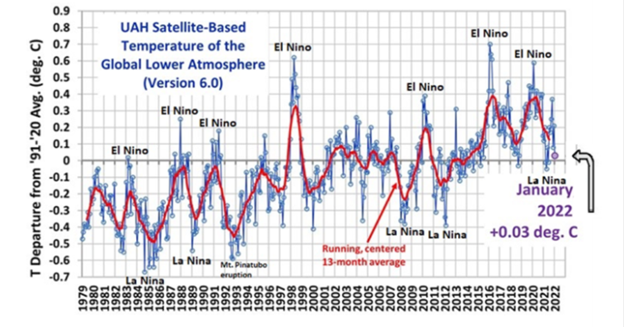A recent Forbes article claims that the recent shortage of the popular hot sauce “Sriracha” is likely due to climate change. This is false. Natural weather patterns in the region of Mexico Sriracha’s chili peppers are grown are not due to the modest warming the earth has experienced over the past decades. Furthermore, a few years of poor production in one region is not evidence of a long-term impact.
The article, “Why Sriracha Prices Are Surging, And Why Climate Change Might Have Something To Do With It,” claims that a production shortage of the chili peppers used by the Hoy Fong company to make sriracha hot sauce is due to “an ongoing drought exacerbated by human-caused climate change,” as well as “back-to-back La Niña events that prolonged it in northern Mexico, where the chilis are grown.”
The recent drought in the southwestern United States and northern Mexico has been held up as proof of the impacts of climate change by many alarmists. The Forbes article repeats the claim that the drought, which has now abated according to the U.S. Drought Monitor, is part of the “the driest 22-year period in more than 1,200 years,” quoting a popularly cited study in Nature Climate Change.
The drought has been overhyped, however. This particular paper published in Nature Climate Change has been covered by Climate Realism writer and meteorologist Anthony Watts previously, in “Sorry, New York Times and NPR, Megadroughts Have Been Far, Far, Worse Than Today,” along with a similar study here.
In the first post, Watts explains that the study authors narrowly defined “megadrought” in order to compose the narrative that the recent 22-year dry spell was the worst in 1200 years.
Other studies that also use tree ring data, like the Nature Climate Change paper, show much longer and more intense dry periods in the southwest in the past, especially in the Middle Ages. (See figure below)

Since the recent drought is not outside of natural variability, what about the triple-dip La Niña events?
La Niña is also a natural event, not due to climate change. It is the cool-phase counterpart to the warming phase of the El Niño-Southern Oscillation (ENSO), a naturally-occurring sea surface temperature pattern in the Pacific. La Niña involves cooler-than-normal water temperatures, and usually causes unusually dry weather in the southwestern United States and Mexico, and unusually wet weather in Western Pacific areas like Australia. While the three La Niña events in a row is a rare situation, it’s not unprecedented. La Niña is not getting more intense due to climate change, as covered by Climate Realism, here, for example. (See figure below)

The Huy Fong sriracha sauce got its start on a small scale in the mid-1980s, meaning the company should have been around for previous extended La Niña events, but it is unclear the company was producing such a volume of hot sauce, or even getting peppers from the same region, during that period.
On the agricultural side of the claim, publicly available data from the United Nations Food and Agriculture Organization (FAO) for chilies and other peppers grown in Mexico show indeed there has been a recent decline in production, since about 2019 through 2021, and presumably into 2022, which corresponds with the recent La Niña events. (See figure below)
Chili pepper production in Mexico hit an all-time production record high as recently as 2018, and in fact saw production records broken fifteen times between 1990 and 2020, a timeframe which has supposedly seen warming which alarmists claim is “catastrophic.”

Climate change acts on timescales of 30 years or greater, not 3 years from 2019 as shown in this graph.
Fortunately, with the forecasted return of the warmer El Niño this year, the issues hindering Huy Fong’s chili source in northern Mexico should decline, if indeed La Niña conditions were to blame instead of some unmentioned agricultural issues.
Regional weather patterns and agricultural shortages are not proof of impacts from climate change, nor can climate change be blamed for those shortages.
Data does not indicate that the regional weather in Northern Mexico since 2019 is more extreme because of the modest warming of global average surface temperature, nor are chili pepper crops in general in any danger. If they were, one would expect evidence to show up in agricultural production data over time.
In fact, crop production woes of a single hot sauce company are not indicative of any kind of widespread climate chaos, or weather issues. Even if Huy Fong sriracha sauce is not currently on shelves, other companies’ similar sriracha chili sauces that have the same ingredients are still widely available, and Forbes would have been wise to point that out, instead of doom-peddling over a particular brand.















Has manufacture been restricted?
https://www.theguardian.com/world/2014/apr/10/sriracha-hot-sauce-public-nuisance-irwindale-california
https://www.vox.com/2014/4/10/5601422/everything-you-need-to-know-about-the-looming-sriracha-apocalypse